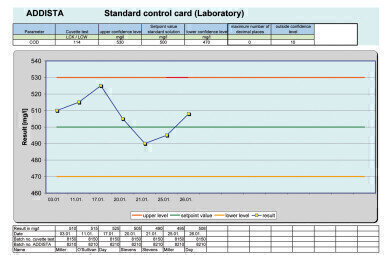Environmental laboratory
Recognised Results Based on Analytical Quality Assurance (AQA)
May 11 2016
The quality of goods and services is crucially important. Purchasers and users have come to expect high quality standards from suppliers and manufacturers. This is why the quality of the services and products on offer is checked and documented several times over (e. g. in accordance with ISO 9001:2000). The results of analyses can also be considered as goods and they have to be able to prove their quality. There is much more to ensuring high quality measurement results than simply the type of analytical method (standard/norm vs. operational analysis) that is used. The care taken over the individual work steps and the quality assurance measures that are implemented, play a much greater role:
Product Quality + Workflow Quality + AQA Measures = Quality Results.
Responsibility for the resultant data lies with the users themselves or their supervisors. Both are therefore liable for any incorrect interpretations and decisions that are made as a consequence of incorrect analysis results. Integrating appropriate quality control measures at the relevant points of the analysis process ensures reliable analysis and minimises the risk of exposure to liability.
How quality assurance is organised in the laboratory
Organising and carrying out AQA in laboratories involves dealing with a variety of international and local standards. Central points are:
- Defining measures to be implemented based on applicable standards
- Monitoring and maintaining analytical equipment
- Training laboratory staff
- Documenting implemented measures and results.
Building blocks of quality control
- Internal quality assurance – This is carried out by the user themselves. Measures include multiple determination, standard measurement, plausibility check, verification of equipment
- External quality assurance – This results from a collaboration between the user and the equipment manufacturer or between different laboratories. Measures include round robin test participation, parallel measurement with other labs, training
- Documentation – AQA starts with pulling a sample and ends with an analysis report in the laboratory logbook. Documentation must be accurate and clearly arranged. It must be obvious who produced what analysis data and when. All results of quality assurance measures should be entered onto the relevant control cards, see picture.
- The operational definitions (definition of measures, frequency and quality control objectives) ensure that individual measures are tailored to suit the needs of the plant.
What do you need to pay attention to?
- All measured results should be within the confidence interval.
- Aim to improve working methods by narrowing the confidence interval.
- Observe trends.
- Analysis values and empirical values must also match.
Conclusion
Regular application of AQA ensures that:
- The results of analyses are traceable.
- The correct status of the analysis system is documented.
- Handling errors can be recognised immediately.
- Comparison of measured results is possible.
- Results of analyses are recognised.
Download your copy of the AQA Guide with a glossary of QA measures and a table with recommendations of frequency and quality targets.
Digital Edition
AET 28.4 Oct/Nov 2024
November 2024
Gas Detection - Go from lagging to leading: why investment in gas detection makes sense Air Monitoring - Swirl and vortex meters will aid green hydrogen production - Beyond the Stack: Emi...
View all digital editions
Events
Jan 12 2025 Abu Dhabi, UAE
Jan 14 2025 Abu Dhabi, UAE
Jan 20 2025 San Diego, CA, USA
Carrefour des Gestions Locales de L'eau
Jan 22 2025 Rennes, France
Safety, Health & Wellbeing LIVE
Jan 22 2025 Manchester, UK




















